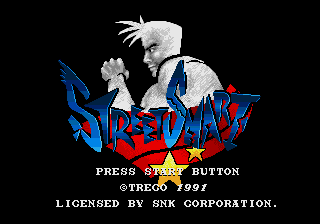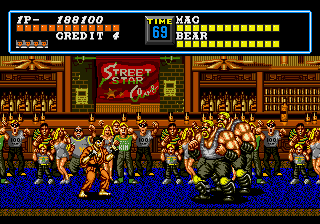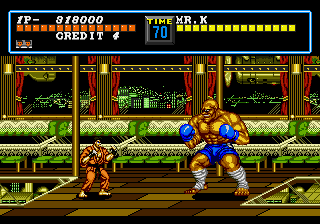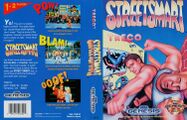Difference between revisions of "Street Smart"
From Sega Retro
m (Text replacement - "==Production Credits==" to "==Production credits==") |
m (→Physical scans) |
||
| (51 intermediate revisions by 8 users not shown) | |||
| Line 1: | Line 1: | ||
| − | |||
{{Bob | {{Bob | ||
| − | | bobscreen=StreetSmart_MDTitleScreen.png | + | | bobscreen=Street Smart MDTitleScreen.png |
| + | | bobscreen2=StreetSmart_MDTitleScreen.png | ||
| + | | tab1=NTSC-U | ||
| + | | tab2=NTSC-J | ||
| publisher=[[Treco]] | | publisher=[[Treco]] | ||
| − | | developer=[[ | + | | developer=[[Treco]] |
| + | | licensor=[[SNK]] | ||
| system=[[Sega Mega Drive]] | | system=[[Sega Mega Drive]] | ||
| − | | | + | | sounddriver= |
| − | | releases={{ | + | | peripherals= |
| − | | md_date_us=1991-06 {{ | + | | players=1-2 |
| + | | genre=Action{{fileref|StreetSmart MD JP Box.jpg}}{{ref|https://web.archive.org/web/20200702232146/https://sega.jp/history/hard/megadrive/software_l.html}} | ||
| + | | originaldevelopers=[[SNK]] | ||
| + | | originalsystem=Arcade boards | ||
| + | | releases={{releasesMD | ||
| + | | md_date_jp=1991-07-19{{ref|https://web.archive.org/web/20200702232146/https://sega.jp/history/hard/megadrive/software_l.html}} | ||
| + | | md_rrp_jp=6,800e{{magref|bemega|1991-07|13}} | ||
| + | | md_code_jp=T-24083 | ||
| + | | md_date_us=1991-06{{magref|egm|23|116}}{{magref|gamepro|23|42}} <!-- DISPUTED PLEASE FIND SOURCE FOR 1991-08--> | ||
| md_rrp_us=49.95 | | md_rrp_us=49.95 | ||
| md_code_us=T-24026 | | md_code_us=T-24026 | ||
| − | |||
| − | |||
| − | |||
}} | }} | ||
| − | | | + | | otherformats={{NonSega|Arcade}} |
| + | }} | ||
| + | '''''{{PAGENAME}}''''' (ストリートスマート) is a [[Sega Mega Drive]] fighting game developed and published by [[Treco]]. It is a port of the 1989 [[SNK]] arcade game of the same name. First released in Japan in July 1991, it was brought to the United States the next month. | ||
| + | |||
| + | ==Gameplay== | ||
| + | {{ScreenThumb|Street Smart, Points.png|width=200|Spending points on attributes}} | ||
| + | {{ScreenThumb|Street Smart, Gamble.png|width=200|Betting on the next fight}} | ||
| + | The game is a fighting game that plays on a two-dimensional plane like a beat-'em-up. Fights take place in enclosed arenas in front of excited onlookers. Players must defeat a series of computer-controlled opponents by draining their health bars within a time limit. Fighters are briefly invulnerable after being hit, so combos are not possible, and fighters cannot harm each other when too close. Losing all of the fighter's health points or running out of time costs a life, but the fighter is immediately revived with a full health bar to finish the fight if the player has extra lives left. The game ends if the player runs out of lives, but there are limited continues available. | ||
| + | |||
| + | There are two selectable fighters, Karate Man, a fast karate expert, and Crusher, a slow but strong wrestler. Karate Man is selected by starting a game with the first control pad and selecting "1P Start"; Crusher is selected by starting a game with the second control pad and selecting "2P Start." If there are two control pads connected, the "2P Start" option is replaced by the "1P and 2P Start" option, which starts a two-player game where both players alternate fighting a computer-controlled opponent, with player one playing Karate Man and player two playing Crusher. There is no competitive two-player mode. | ||
| + | |||
| + | Fighters can move from side to side with {{left}} or {{right}} but also back and forth with {{up}} and {{down}}. They jump with {{C}}. They punch with {{A}} and kick with {{B}}. Punches are faster, but kicks have longer range. Their moves change if the opponent is in close range. They can jump kick with {{B}} after jumping, but this can only hit airborne opponents. They cannot punch in midair. Fighters can backflip to escape opponents with {{A}}+{{B}}. Each fighter has a special technique performed with {{B}}+{{C}}. Using a special technique costs one health point, and they cannot be used at all if the fighter has three or fewer health points remaining. | ||
| + | |||
| + | Players earn points from each fight, with later fights awarding more points. After each fight, these points can be spent improving the attributes of the fighters: life (the length of the health bar), power (the damage dealt by the fighter), and defense (the resistance to damage from opponents). Opponents too become more powerful as the game progresses. | ||
| + | |||
| + | Players also earn money from each match (with victorious fights earning more money). Before every fight except the first, players can gamble their earnings on who will win (players are even able to bet on their opponents). Players lose all of their money when they lose a life. There are three endings to the game, depending on how much money the players have when the final boss is defeated. The best ending requires $8,000,000 in earnings, which is only possible to achieve through betting. The normal ending requires more than $100,000, which is also the amount earned from winning the final fight. The worst ending requires exactly $100,000, which is only possible to achieve by losing a life in the final fight or losing everything in the final bet. | ||
| + | |||
| + | Players can determine the number of extra lives (1 to 4), the number of continues (3 or 5), and the difficulty (Easy, Normal, or Hard) in the options prior to starting the game. | ||
| + | |||
| + | ===Fighters=== | ||
| + | {{InfoTable| | ||
| + | {{InfoRow | ||
| + | | title=Karate Man ({{rolloverText|空手家|Karateka}}) | ||
| + | | sprite={{sprite|Street Smart, Characters.png|2|crop_width=40|crop_x=0}} | ||
| + | | desc=A Japanese man dressed in a red karate gi. He is a martial arts expert with lightning quick attacks. | ||
| + | |||
| + | His special move is the Dragon's Tail Technique (performed with {{B}}+{{C}}). He punches several times rapidly, then finishes with an uppercut. He is invincible while performing the move, but it costs one health point. This move would become a staple of the ''[[Art of Fighting]]'' series, where it is called Zanretsuken and performed by Ryo and Mr. Karate in the first entry. | ||
| + | }} | ||
| + | {{InfoRow | ||
| + | | title=Crusher ({{rolloverText|クラッシャー|Kurasshaa}}) | ||
| + | | sprite={{sprite|Street Smart, Characters.png|2|crop_width=40|crop_x=40}} | ||
| + | | desc=An American man dressed in blue tights. He is a professional wrestler with strong attacks but lacking speed. | ||
| + | |||
| + | His special move is the Kansas Tornado Kick (performed with {{B}}+{{C}}). He spins on an axis while holding his leg out in a kick, then does a crouching kick. He is invincible while performing the move, but it costs one health point. | ||
| + | }} | ||
}} | }} | ||
| − | |||
| − | + | ===Opponents=== | |
| + | Opponents are always fought in order. Two matches are against two opponents at once. | ||
| + | {{gallery|widths=200|screens=yes| | ||
| + | {{gitem|Street Smart, Stage 1.png|Bobby}} | ||
| + | {{gitem|Street Smart, Stage 2.png|Sam}} | ||
| + | {{gitem|Street Smart, Stage 3.png|Mike}} | ||
| + | {{gitem|Street Smart, Stage 4.png|Brown}} | ||
| + | {{gitem|Street Smart, Stage 5.png|Larry}} | ||
| + | {{gitem|Street Smart, Stage 6.png|Max & Jone}} | ||
| + | {{gitem|Street Smart, Stage 7.png|Mac & Bear}} | ||
| + | {{gitem|Street Smart, Stage 8.png|Tommy}} | ||
| + | {{gitem|Street Smart, Stage 9.png|Mr. K}} | ||
| + | }} | ||
==Production credits== | ==Production credits== | ||
| − | '''Boss:''' E.Kawasaki | + | {{multicol| |
| − | '''Producer:''' Tsuka | + | {{creditstable| |
| − | '''Designer:''' Nobuhiko, Wara2, Wada UG, Helper1, Natsuji | + | *'''Boss:''' E.Kawasaki |
| − | '''Helper:''' Akira Goto | + | *'''Producer:''' Tsuka |
| − | '''Sound:''' Jojoha Kitamura | + | *'''Designer:''' Nobuhiko, Wara2, Wada UG, Helper1, Natsuji |
| − | '''Programmer:''' Imasa.F | + | *'''Helper:''' Akira Goto |
| − | '''Sound Programmer:''' Doda... | + | *'''Sound:''' Jojoha Kitamura |
| − | '''Special Thanks:''' Shinchan, Bento‑ Matsuyama, Kura, and... SNK Arcade version Staff. | + | *'''Programmer:''' Imasa.F |
| − | '''Presented by:''' [[Treco|American Treco Corporation]]. | + | *'''Sound Programmer:''' Doda... |
| + | *'''Special Thanks:''' Shinchan, Bento‑ Matsuyama, Kura, and... SNK Arcade version Staff. | ||
| + | *'''Presented by:''' [[Treco|Treco Corporation]]. | ||
| + | | source=In-game credits (JP) | ||
| + | | pdf=StreetSmart MD JP SSCredit.pdf | ||
| + | | console=MD | ||
| + | }} | ||
| + | }} | ||
| + | {{hr}} | ||
| + | {{multicol| | ||
| + | {{creditstable| | ||
| + | *'''Boss:''' E.Kawasaki | ||
| + | *'''Producer:''' Tsuka | ||
| + | *'''Designer:''' Nobuhiko, Wara2, Wada UG, Helper1, Natsuji | ||
| + | *'''Helper:''' Akira Goto | ||
| + | *'''Sound:''' Jojoha Kitamura | ||
| + | *'''Programmer:''' Imasa.F | ||
| + | *'''Sound Programmer:''' Doda... | ||
| + | *'''Special Thanks:''' Shinchan, Bento‑ Matsuyama, Kura, and... SNK Arcade version Staff. | ||
| + | *'''Presented by:''' [[Treco|American Treco Corporation]]. | ||
| + | | source=In-game credits (US) | ||
| + | | pdf=Street Smart MD credits.pdf | ||
| + | | console=MD | ||
| + | }} | ||
| + | }} | ||
| − | ==Promotional | + | ==Magazine articles== |
| − | + | {{mainArticle|{{PAGENAME}}/Magazine articles}} | |
| − | + | ||
| − | + | ==Promotional material== | |
| − | + | {{gallery | |
| + | |{{GalleryPrintAd | ||
| + | |sv|4|29 | ||
| + | |megaplay|4|11 | ||
| + | }} | ||
| + | |||
| + | |{{GalleryPrintAd | ||
| + | |sv|5|13 | ||
| + | |gpsg|0203|2-5 | ||
| + | |gamepro|25|13 | ||
| + | }} | ||
| + | |{{galleryPrintAd|bemega|1991-06|8-9}} | ||
| + | |{{galleryPrintAd | ||
| + | |bemega|1991-07|13 | ||
| + | |mdfan|18|89}} | ||
| + | |{{galleryPrintAd|bemega|1991-08|8-9}} | ||
| + | }} | ||
==Physical scans== | ==Physical scans== | ||
| − | {{ratings | + | {{ratings|MD}} |
| − | | | ||
| − | |||
| − | |||
| − | |||
| − | |||
| − | |||
| − | |||
| − | |||
| − | |||
| − | |||
| − | |||
| − | |||
| − | |||
| − | |||
| − | |||
| − | |||
| − | |||
| − | |||
| − | |||
| − | |||
| − | |||
| − | |||
| − | |||
| − | |||
| − | |||
| − | }} | ||
{{Scanbox | {{Scanbox | ||
| − | |||
| − | |||
| − | |||
| − | |||
| − | |||
| console=Mega Drive | | console=Mega Drive | ||
| region=JP | | region=JP | ||
| Line 76: | Line 138: | ||
| cart=StreetSmart MD JP Cart.jpg | | cart=StreetSmart MD JP Cart.jpg | ||
| carttop=StreetSmart MD JP CartTop.jpg | | carttop=StreetSmart MD JP CartTop.jpg | ||
| + | | manual=StreetSmart MD JP Manual.pdf | ||
| + | }}{{Scanbox | ||
| + | | console=Mega Drive | ||
| + | | region=US | ||
| + | | cover=StreetSmart MD US Box.jpg | ||
| + | | cart=StreetSmart MD US Cart.jpg | ||
| + | | manual=Street Smart MD US Manual.pdf | ||
| + | | item1=StreetSmart MD US pcb.jpg | ||
| + | | item1name=PCB | ||
}} | }} | ||
| + | |||
| + | ==Technical information== | ||
| + | {{mainArticle|{{PAGENAME}}/Technical information}} | ||
| + | |||
| + | ==References== | ||
| + | <references/> | ||
| + | |||
| + | {{StreetSmartOmni}} | ||
Latest revision as of 14:01, 4 September 2024
| |||||||||||||||
| Street Smart | |||||||||||||||
|---|---|---|---|---|---|---|---|---|---|---|---|---|---|---|---|
| System(s): Sega Mega Drive | |||||||||||||||
| Publisher: Treco | |||||||||||||||
| Developer: Treco | |||||||||||||||
| Licensor: SNK | |||||||||||||||
| Original system(s): Arcade boards | |||||||||||||||
| Developer(s) of original games: SNK | |||||||||||||||
| Genre: Action[1][2] | |||||||||||||||
| Number of players: 1-2 | |||||||||||||||
| |||||||||||||||
|
Street Smart (ストリートスマート) is a Sega Mega Drive fighting game developed and published by Treco. It is a port of the 1989 SNK arcade game of the same name. First released in Japan in July 1991, it was brought to the United States the next month.
Contents
Gameplay
The game is a fighting game that plays on a two-dimensional plane like a beat-'em-up. Fights take place in enclosed arenas in front of excited onlookers. Players must defeat a series of computer-controlled opponents by draining their health bars within a time limit. Fighters are briefly invulnerable after being hit, so combos are not possible, and fighters cannot harm each other when too close. Losing all of the fighter's health points or running out of time costs a life, but the fighter is immediately revived with a full health bar to finish the fight if the player has extra lives left. The game ends if the player runs out of lives, but there are limited continues available.
There are two selectable fighters, Karate Man, a fast karate expert, and Crusher, a slow but strong wrestler. Karate Man is selected by starting a game with the first control pad and selecting "1P Start"; Crusher is selected by starting a game with the second control pad and selecting "2P Start." If there are two control pads connected, the "2P Start" option is replaced by the "1P and 2P Start" option, which starts a two-player game where both players alternate fighting a computer-controlled opponent, with player one playing Karate Man and player two playing Crusher. There is no competitive two-player mode.
Fighters can move from side to side with ![]() or
or ![]() but also back and forth with
but also back and forth with ![]() and
and ![]() . They jump with
. They jump with ![]() . They punch with
. They punch with ![]() and kick with
and kick with ![]() . Punches are faster, but kicks have longer range. Their moves change if the opponent is in close range. They can jump kick with
. Punches are faster, but kicks have longer range. Their moves change if the opponent is in close range. They can jump kick with ![]() after jumping, but this can only hit airborne opponents. They cannot punch in midair. Fighters can backflip to escape opponents with
after jumping, but this can only hit airborne opponents. They cannot punch in midair. Fighters can backflip to escape opponents with ![]() +
+![]() . Each fighter has a special technique performed with
. Each fighter has a special technique performed with ![]() +
+![]() . Using a special technique costs one health point, and they cannot be used at all if the fighter has three or fewer health points remaining.
. Using a special technique costs one health point, and they cannot be used at all if the fighter has three or fewer health points remaining.
Players earn points from each fight, with later fights awarding more points. After each fight, these points can be spent improving the attributes of the fighters: life (the length of the health bar), power (the damage dealt by the fighter), and defense (the resistance to damage from opponents). Opponents too become more powerful as the game progresses.
Players also earn money from each match (with victorious fights earning more money). Before every fight except the first, players can gamble their earnings on who will win (players are even able to bet on their opponents). Players lose all of their money when they lose a life. There are three endings to the game, depending on how much money the players have when the final boss is defeated. The best ending requires $8,000,000 in earnings, which is only possible to achieve through betting. The normal ending requires more than $100,000, which is also the amount earned from winning the final fight. The worst ending requires exactly $100,000, which is only possible to achieve by losing a life in the final fight or losing everything in the final bet.
Players can determine the number of extra lives (1 to 4), the number of continues (3 or 5), and the difficulty (Easy, Normal, or Hard) in the options prior to starting the game.
Fighters
| Karate Man (空手家) | |
|---|---|
| A Japanese man dressed in a red karate gi. He is a martial arts expert with lightning quick attacks.
His special move is the Dragon's Tail Technique (performed with | |
| Crusher (クラッシャー) | |
| An American man dressed in blue tights. He is a professional wrestler with strong attacks but lacking speed.
His special move is the Kansas Tornado Kick (performed with |
Opponents
Opponents are always fought in order. Two matches are against two opponents at once.
Production credits
- Boss: E.Kawasaki
- Producer: Tsuka
- Designer: Nobuhiko, Wara2, Wada UG, Helper1, Natsuji
- Helper: Akira Goto
- Sound: Jojoha Kitamura
- Programmer: Imasa.F
- Sound Programmer: Doda...
- Special Thanks: Shinchan, Bento‑ Matsuyama, Kura, and... SNK Arcade version Staff.
- Presented by: Treco Corporation.
- Boss: E.Kawasaki
- Producer: Tsuka
- Designer: Nobuhiko, Wara2, Wada UG, Helper1, Natsuji
- Helper: Akira Goto
- Sound: Jojoha Kitamura
- Programmer: Imasa.F
- Sound Programmer: Doda...
- Special Thanks: Shinchan, Bento‑ Matsuyama, Kura, and... SNK Arcade version Staff.
- Presented by: American Treco Corporation.
Magazine articles
- Main article: Street Smart/Magazine articles.
Promotional material
also published in:
- Game Players Sega Guide! (US) #0203: "Vol. 2, No. 3: June/July 1991" (1991-0x-xx)[9]
- GamePro (US) #25: "August 1991" (1991-xx-xx)[10]
also published in:
- Mega Drive Fan (JP) #18: "July 1991" (1991-06-08)[11]
Physical scans
| Sega Retro Average | |||||||||||||||||||||||||||||||||||||||||||||||||||||||||||||||||||||||||||||||||||||||||||||||||||||||||||||||||||||||
|---|---|---|---|---|---|---|---|---|---|---|---|---|---|---|---|---|---|---|---|---|---|---|---|---|---|---|---|---|---|---|---|---|---|---|---|---|---|---|---|---|---|---|---|---|---|---|---|---|---|---|---|---|---|---|---|---|---|---|---|---|---|---|---|---|---|---|---|---|---|---|---|---|---|---|---|---|---|---|---|---|---|---|---|---|---|---|---|---|---|---|---|---|---|---|---|---|---|---|---|---|---|---|---|---|---|---|---|---|---|---|---|---|---|---|---|---|---|---|---|
|
| 51 | |
|---|---|
| Based on 23 reviews | |
| Mega Drive, JP |
|---|
Technical information
- Main article: Street Smart/Technical information.
References
- ↑ File:StreetSmart MD JP Box.jpg
- ↑ 2.0 2.1 https://sega.jp/history/hard/megadrive/software_l.html (Wayback Machine: 2020-07-02 23:21)
- ↑ Beep! MegaDrive, "July 1991" (JP; 1991-06-08), page 13
- ↑ Electronic Gaming Monthly, "June 1991" (US; 1991-xx-xx), page 116
- ↑ GamePro, "June 1991" (US; 1991-xx-xx), page 42
- ↑ File:StreetSmart MD JP SSCredit.pdf
- ↑ File:Street Smart MD credits.pdf
- ↑ Mega Play, "May/June 1991" (US; 1991-0x-xx), page 11
- ↑ Game Players Sega Guide!, "Vol. 2, No. 3: June/July 1991" (US; 1991-0x-xx), page 2
- ↑ GamePro, "August 1991" (US; 1991-xx-xx), page 13
- ↑ Mega Drive Fan, "July 1991" (JP; 1991-06-08), page 89
- ↑ Aktueller Software Markt, "November 1991" (DE; 1991-10-11), page 154
- ↑ Beep! MegaDrive, "August 1991" (JP; 1991-07-08), page 34
- ↑ Consoles +, "Septembre 1991" (FR; 1991-09-04), page 84
- ↑ Console XS, "June/July 1992" (UK; 1992-04-23), page 134
- ↑ Cool Gamer, "9" (RU; 2002-10-13), page 209
- ↑ Computer & Video Games, "September 1991" (UK; 1991-08-15), page 96
- ↑ Electronic Gaming Monthly, "July 1991" (US; 1991-xx-xx), page 22
- ↑ Famitsu, "1991-08-02" (JP; 1991-07-19), page 1
- ↑ GamePro, "October 1991" (US; 1991-xx-xx), page 60
- ↑ Games-X, "1st-7th August 1991" (UK; 1991-08-01), page 39
- ↑ Hippon Super, "August 1991" (JP; 1991-07-04), page 87
- ↑ Joystick, "Septembre 1991" (FR; 1991-0x-xx), page 160
- ↑ Sega Mega Drive Advanced Gaming, "November 1992" (UK; 1992-xx-xx), page 79
- ↑ Sega Mega Drive Advanced Gaming, "January 1993" (UK; 199x-xx-xx), page 94
- ↑ Mega Drive Fan, "October 1991" (JP; 1991-09-xx), page 107
- ↑ Mega Play, "May/June 1991" (US; 1991-0x-xx), page 43
- ↑ MegaTech, "Xmas 1991" (UK; 1991-12-06), page 80
- ↑ Mean Machines Sega, "October 1992" (UK; 1992-09-xx), page 140
- ↑ Sega Power, "October 1991" (UK; 1991-09-05), page 54
- ↑ Sega Power, "December 1991" (UK; 1991-10-30), page 36
- ↑ Sega Pro, "April 1992" (UK; 1992-03-19), page 29
- ↑ Sega Pro, "April 1993" (UK; 1993-03-11), page 67
- ↑ Sega Saturn Magazine, "September 1995" (JP; 1995-08-08), page 87
| Street Smart | |
|---|---|
|
Main page | Comparisons | Hidden content | Magazine articles | Reception | Region coding | Technical information | Bootlegs
Prototypes: 1990-06-29
| |





























